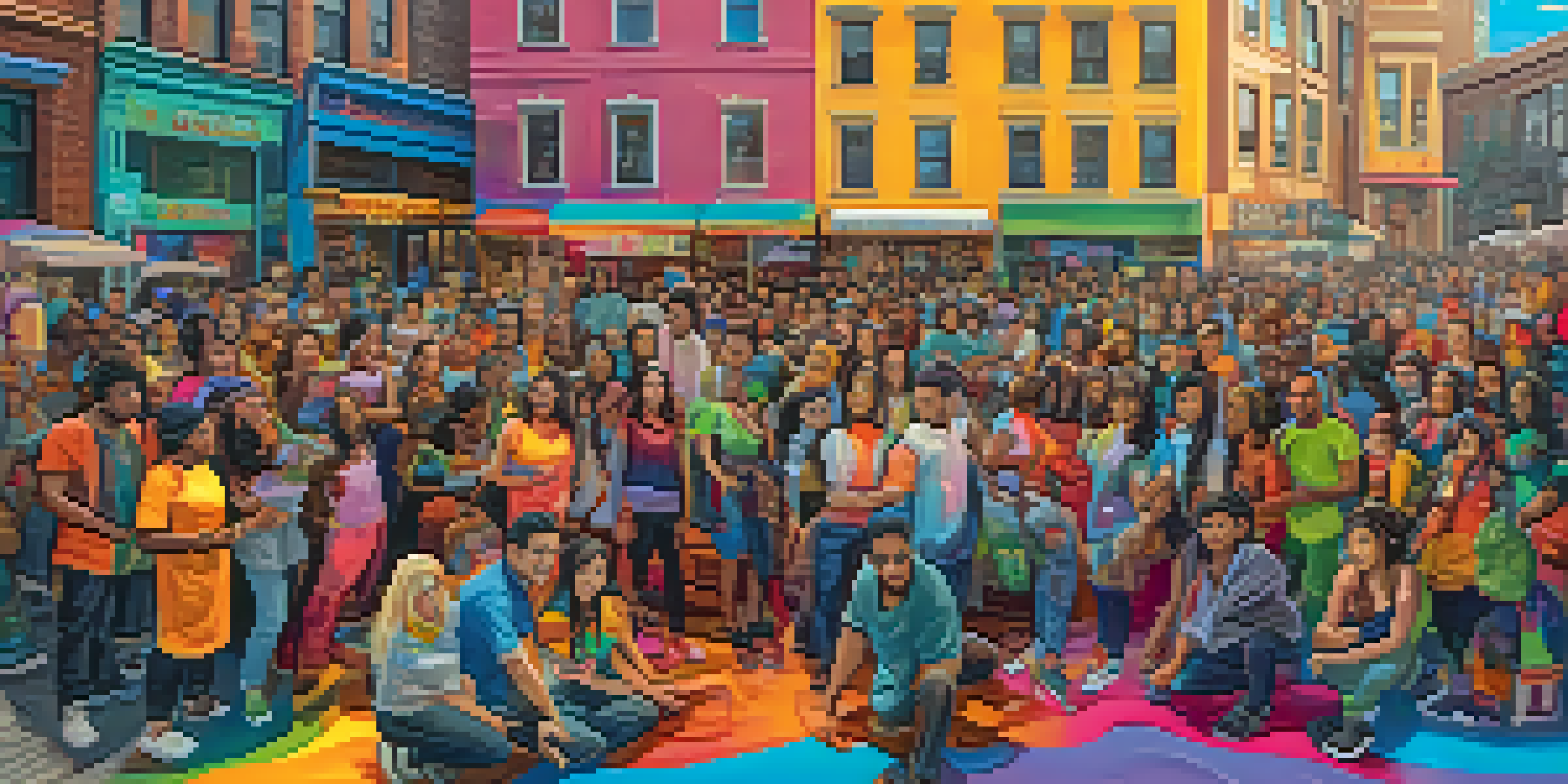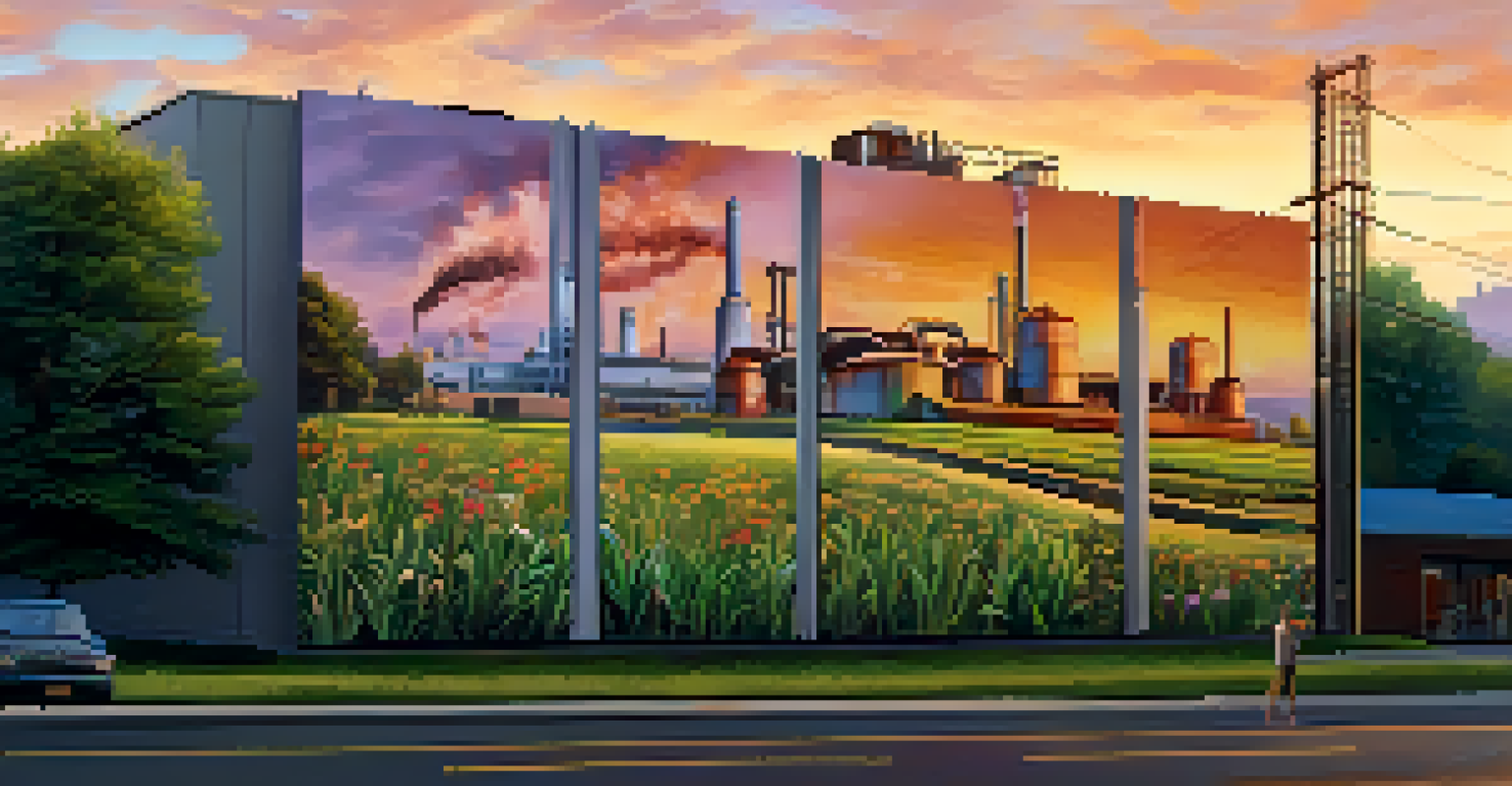Crowdsourced Digital Art Projects for Social Change

Understanding Crowdsourced Digital Art Projects
Crowdsourced digital art projects leverage the creativity of diverse individuals to create impactful artworks. These initiatives invite people from various backgrounds to contribute their unique perspectives, resulting in a rich tapestry of ideas and expressions. By pooling together talents, these projects not only democratize art but also amplify voices that may otherwise go unheard.
Art is not a mirror to hold up to society, but a hammer with which to shape it.
Such projects often utilize platforms that allow for easy participation, making it accessible for anyone with an internet connection. This inclusivity can lead to a sense of community and shared purpose, as contributors work towards a common goal. Ultimately, this collaborative spirit serves as a catalyst for social change, sparking conversations around important issues.
One notable example is the global initiative 'Art for Change,' where artists and activists join forces to create works that reflect societal challenges. By merging art with advocacy, these projects can resonate deeply with audiences, inspiring them to reflect on their role in fostering change.
The Role of Technology in Crowdsourced Art
Technology plays a pivotal role in facilitating crowdsourced digital art projects. With social media platforms and online galleries, artists can easily share their work and rally support from a global audience. This digital landscape not only allows for widespread participation but also enables the rapid dissemination of messages that drive social awareness.

For instance, interactive websites can host virtual exhibitions, allowing contributors to upload their artwork and share their stories. This kind of engagement fosters a sense of ownership among participants, making them feel invested in the project's success. Furthermore, technology empowers creators to experiment with various mediums, from digital painting to video art.
Crowdsourcing Empowers Art and Voices
Crowdsourced digital art projects democratize creativity, allowing diverse individuals to contribute unique perspectives and amplify underrepresented voices.
As a result, the art produced can take many forms, each serving as a powerful tool for storytelling and advocacy. The blend of creativity and technology not only enhances the artistic expression but also amplifies the impact of the messages conveyed.
Highlighting Key Themes in Social Change
Crowdsourced digital art projects often explore themes that resonate deeply with societal issues. Topics like climate change, racial equality, and mental health frequently surface in these initiatives, allowing artists to address pressing concerns through their work. This thematic focus helps to raise awareness and encourages dialogue around these critical subjects.
Creativity takes courage.
By visualizing complex issues, artists can simplify difficult conversations and make them more relatable. For example, a digital mural depicting the effects of pollution on local communities can evoke emotional responses that lead to action. Such artworks not only inform but also inspire viewers to become advocates for change.
Moreover, these projects can serve as a historical record, capturing the zeitgeist of current events. As they evolve alongside societal movements, they reflect the collective consciousness and aspirations of communities striving for a better future.
Case Studies of Successful Projects
Several crowdsourced digital art projects have gained traction, showcasing the power of collective creativity. One standout project is 'We Rise,' which invited artists to create pieces that represented their visions for social justice. This initiative not only highlighted various perspectives but also fostered a sense of solidarity among participants.
Similarly, the 'Postcards from the Pandemic' project encouraged artists to submit digital postcards that captured their experiences during lockdowns. This project not only provided an outlet for expression but also created a visual narrative of resilience amid adversity. The resulting collection offered insights into the shared struggles and triumphs of individuals during a challenging time.
Technology Enhances Artistic Engagement
The use of technology in art projects facilitates widespread participation, enabling artists to share their work and stories with a global audience.
These case studies demonstrate the potential of crowdsourced art to engage communities and inspire action. By showcasing diverse voices, these projects can spark conversations and lead to meaningful change.
Engagement and Community Building
One of the most significant benefits of crowdsourced digital art projects is their ability to foster engagement and community building. Participants often connect over shared passions, forming bonds that extend beyond the project itself. This sense of belonging can empower individuals, encouraging them to take an active role in their communities.
For example, social media platforms often serve as gathering places for contributors to discuss their ideas and experiences. These discussions can lead to collaborations, workshops, and even local events that promote further engagement. When individuals feel connected to a cause, they are more likely to become advocates for change.
Ultimately, the relationships forged through these projects can have a lasting impact, creating networks of support that continue to thrive long after the art is completed. This community-driven approach not only enriches the creative process but also strengthens the collective mission.
The Impact of Art on Social Movements
Art has long played a crucial role in social movements, serving as a powerful medium for expression and activism. Crowdsourced digital art projects continue this tradition by providing a platform for diverse voices to advocate for change. Through compelling visuals and narratives, artists can convey messages that resonate with audiences on both emotional and intellectual levels.
For instance, during movements like Black Lives Matter, digital artworks have emerged as poignant symbols of resistance and solidarity. These pieces not only capture the urgency of the moment but also motivate individuals to join the fight for justice. The ability of art to transcend language and cultural barriers makes it an invaluable tool for social movements.
Art as a Catalyst for Social Change
Crowdsourced art initiatives tackle pressing societal issues, fostering community engagement and inspiring action through powerful visual narratives.
Moreover, as these artworks circulate online, they can reach a wider audience than traditional forms of activism. This amplifies the message and encourages solidarity across different communities, highlighting the interconnectedness of social struggles.
Challenges and Considerations
While crowdsourced digital art projects offer numerous benefits, they also face challenges that need to be addressed. One significant concern is the potential for misrepresentation or appropriation of cultural symbols. Artists must navigate these complexities carefully to ensure that their work respects the communities they aim to represent.
Additionally, there can be issues related to digital accessibility and the digital divide. Not everyone has equal access to technology, which can limit participation in these projects. It's essential for organizers to create inclusive environments that invite contributions from all demographics, ensuring that diverse voices are heard.

By acknowledging these challenges, projects can evolve and adapt, finding ways to foster inclusivity while remaining true to their mission. Continuous dialogue and reflection are crucial in maintaining the integrity of crowdsourced art initiatives.
Looking Ahead: The Future of Crowdsourced Art
As we look to the future, the potential for crowdsourced digital art projects to drive social change remains immense. With the continued evolution of technology, these initiatives can reach even larger audiences and engage more participants. Innovations such as virtual reality and augmented reality could further enhance the immersive experience of digital art, making it an even more powerful medium for advocacy.
Moreover, as social issues grow in complexity, the need for diverse perspectives will become increasingly important. Crowdsourced art can serve as a bridge, connecting communities and fostering understanding through shared experiences. By highlighting stories that resonate on a human level, art can inspire empathy and action.
Ultimately, the future of crowdsourced digital art lies in its ability to adapt and respond to the changing landscape of society. As artists and communities continue to collaborate, the impact of their collective efforts will undoubtedly shape the narrative of social change for years to come.